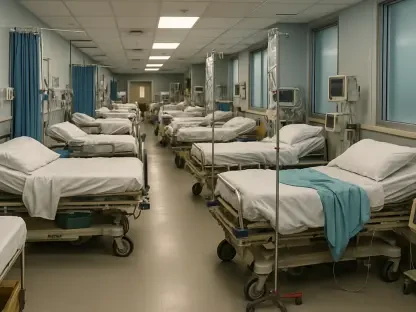In a significant move for mental health care providers, the Centers for Medicare and Medicaid Services (CMS) has rolled out a series of updates to the Inpatient Psychiatric Facilities (IPF) Prospective Payment System (PPS) for fiscal year 2026. These changes, detailed in a recent final rule, promise to reshape the financial landscape for IPFs under Medicare by introducing a notable payment increase and refining regulatory frameworks. Beyond the monetary adjustments, CMS is also revising quality reporting measures and exploring innovative tools to enhance transparency in care delivery. This development comes at a critical juncture when IPFs are navigating rising operational costs and evolving patient needs. The updates reflect a broader commitment to aligning reimbursement with current realities while ensuring that quality metrics remain meaningful and actionable for facilities across diverse settings. As these changes unfold, stakeholders are keenly observing how they will impact both financial stability and care standards in the mental health sector.
Financial Adjustments for Enhanced Support
The cornerstone of the CMS updates lies in a substantial 2.5% payment increase for IPFs, a figure derived from a 3.2% market basket update tempered by a 0.7% productivity cut. This adjustment is expected to translate into a 2.4% overall rise in total payments, injecting an additional $70 million into the system compared to the prior fiscal year. Such a financial boost is poised to provide much-needed relief to facilities grappling with escalating costs, particularly in areas like staffing and infrastructure maintenance. Importantly, the update also includes revised facility-level adjustment factors, focusing on teaching status and rural location. By leveraging more recent cost data from a defined period, CMS aims to ensure that payments better reflect the unique challenges faced by these facilities. This targeted approach underscores an intent to distribute resources more equitably, enabling IPFs to sustain operations without compromising on care quality amidst diverse economic pressures.
Another key aspect of the financial recalibration involves adjustments to teaching caps for resident full-time equivalents, as guided by legislative provisions. Implemented in a budget-neutral manner, these changes aim to balance fiscal responsibility with the need to support educational roles within IPFs. The updated caps recognize the critical role of teaching facilities in training future mental health professionals, ensuring they are adequately compensated for their dual mission of education and patient care. Additionally, rural IPFs stand to benefit from recalibrated adjustments that account for higher operational expenses often encountered in less accessible regions. This nuanced revision of payment structures signals CMS’s recognition of the varied landscapes in which IPFs operate. By addressing these disparities, the agency seeks to fortify the financial foundation of facilities that serve as lifelines for underserved communities, ultimately fostering a more resilient mental health care network.
Quality Reporting Overhaul and Policy Refinements
CMS is not stopping at financial adjustments; significant modifications to the IPF Quality Reporting (IPFQR) Program are also part of the final rule. One prominent change is the shift in the reporting period for a specific emergency department visit measure, moving from a one-year calendar cycle to a two-year fiscal cycle for better alignment with comparable metrics. Furthermore, four existing measures related to health equity, vaccination coverage, and social drivers of health are being discontinued starting with the current reporting cycle for FY 2026 payment determination. This streamlining effort aims to reduce administrative burdens while focusing on data that offers the most relevant insights into care quality. By refining what facilities are required to report, CMS hopes to enhance the efficiency of quality assessments, allowing IPFs to prioritize patient outcomes over cumbersome documentation.
In tandem with reporting changes, CMS has revised the Extraordinary Circumstances Exceptions (ECE) policy to better support facilities facing unexpected challenges in meeting requirements. The updated policy now explicitly includes extensions as a form of relief, with the request timeframe adjusted to 60 days based on stakeholder input. This adjustment reflects a pragmatic approach to balancing accountability with flexibility, acknowledging that unforeseen events can disrupt even the most diligent operations. Additionally, CMS is laying the groundwork for future transparency initiatives by soliciting public feedback on a potential five-star rating system for IPFs on a widely used comparison tool. Such a system could empower patients and families with clearer information about care quality, fostering informed decision-making. These policy refinements illustrate a forward-thinking strategy to modernize oversight while addressing the practical realities IPFs encounter daily.
Shaping a Sustainable Future for IPF Care
Reflecting on the strides made through these updates, it becomes evident that CMS has prioritized both immediate financial relief and long-term systemic improvements for IPFs. The payment increases and facility-specific adjustments address pressing economic challenges, while the quality reporting revisions streamline administrative processes for a better focus on patient care. Looking ahead, the exploration of a star rating system hints at a future where transparency could drive higher standards across the board. For IPFs, the next steps involve adapting to these regulatory shifts by optimizing resource allocation and refining data collection practices to align with updated metrics. Engaging with CMS through public feedback opportunities also emerges as a critical action to shape tools like the proposed rating system. As the mental health care landscape continues to evolve, these updates lay a robust foundation for sustainable growth, ensuring that facilities are better equipped to meet both current demands and future challenges with resilience and innovation.









